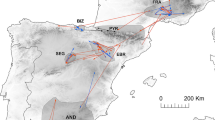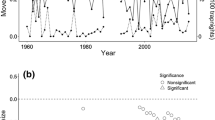Summary
In a sample of 240 juvenile field voles 8% of the males and 22% of the females reached sexual maturity within their natal home range. Among individuals retrapped as adults, 58% of males and 23% of females had dispersed, i.e. had moved more than one home range diameter. The mean distance moved for males (58.5 m) exceeded that for females (28.6 m). Male movement distances were negatively associated with total density, and with density of adult females, but not with male density. Female movements were not related to population density. There were no relation between sex ratio and distance moved. The distribution of distances moved for both males and females fit a geometrical distribution, suggesting the importance of competitive processes.
Similar content being viewed by others
References
Boonstra R, Krebs CJ, Gaines MS, Johnson ML, Craine ITM (1987). Natal philopatry and breeding systems in voles (Microtus spp.). J Anim Ecol 56:655–673
Buechner M (1987) A geometric model of vertebrate dispersal: Tests and implications. Ecology 68:310–318
Caley MJ (1987) Dispersal and inbreeding avoidance in muskrats. Anim Behav 35:1225–1233
Christian JJ (1970) Social subordination, population density, and mammalian evolution. Science 168:84–90
Clutton-Brock TH, Guinness FE, Albon SD (1982) Red Deer. Behavior and Ecology of Two Sexes. Edinburgh University Press, Edinburgh.
Cockburn A, Scott MP, Scotts DJ (1985) Inbreeding avoidance and male-biased natal dispersal in Antechinus spp. (Masrsupialia: Dasyuridae). Anim Behav 33:908–915
Dobson FS (1979) An experimental study of dispersal in the California ground squirrel. Ecology 60:1103–1109
Dobson FS (1982) Competition for mates and predominant juvenile male dispersal in mammals. Anim Behav 30:1183–1192
Dobson FS, Jones WT (1985) Multiple causes of dispersal Am Nat 126:855–858
Grenwood PJ (1980) Mating systems, philopatry and dispersal in birds and mammals. Anim Behav 28:1140–1162
Hestbeck JB (1982) Population regulation of cyclic mammals: The social fence hypothesis. Oikos 39:157–163
Holekamp KE (1984a) Dispersal in ground-dwelling sciurids. In: Murie JO, Michener GR (eds) The Biology of Ground-Dwelling Squirrels. University of Nebraska Press, Lincoln, Nebraska
Holekamp KE (1984b) Natal dispersal in Belding's ground squirrels (Spermophilus beldingi). Behav Ecol Sociobiol 16:21–30
Jennrich RI, Turner FB (1969) Measurement of non-circular home range. J theor Biol 22:227–237
Jones WT, Waser PM, Elliott LF, Link NE, Bush BB (1988) Philopatry, dispersal, and hapitat saturation in the banner-tailed kangaroo rat, Dipodomys spectabilis. Ecology 69:1466–1473
Krebs CJ (1978a) A review of the Chitty Hypothesis of population regulation. Can J Zool 56:2463–2480
Krebs CJ (1978b) Aggression, dispersal, and cyclic changes in populations of small rodents. In: Krames L, Pliner P, Alloway T (eds) Aggression dominance, and individual spacing. Plenum Press, New York
Liberg O, Schantz T von (1985) Sex-biased philopatry and dispersal in birds and mammals: the Oedipus hypothesis. Am Nat 126:129–135
Lidicker WZ (1975) The role of dispersal in the demography of small mammals. In: Golley FB, Petrusewicz K, Ryszkowski L (eds) Small Mammals: Productivity and dynamics of populations. Cambridge University Press, London
Lidicker WZ (1985) Dispersal. In: Tamarin RH (ed) Biology of New World Microtus. American Society of Mammalogist, Special Publication No. 8
Mazurkiewicz M, Rajska E (1975) Dispersion of young bank voles from their place of birth. Acta Theriol 20:71–81
Moore J, Ali R (1984) Are dispersal and inbreeding avoidance related? Anim Behav 32:94–112
Myllymäki A (1977) Intraspecific competition and home range dynamics in the field vole Microtus agrestis. Oikos 29:553–569
Ostfeld RS (1985) Limiting resources and territoriality in microtine rodents. Am Nat 126:1–15
Packer C (1979) Inter-troop transfer and inbreeding avoidance in Papio anubis. Anim Behav 27:1–36
Pugh SR, Tamarin RH (1988) Inbreeding in a population of meadow voles, Microtus pennsylvanicus. Can J Zool 66:1831–1834
Pusey AE (1987) Sex-biased dispersal and inbreeding avoidance in birds and mammals. Trends Ecol Evol 2:295–299
Sherman PW (1980) The limits of ground squirrel nepotism. In: Barlow GW, Silverberg J (eds) Sociobiogy: Beyond Nature/Nurture?. AAAS Selected Symposium 35, pp 505–544
Smith AT, Ivins BL (1983) Colonization in a pika population: dispersal vs philopatry. Behav Ecol Sociobiol 13:37–47
Swingland IR, Greenwood PJ (1984) The Ecology of Animal Movement. Clarendon Press, Oxford
Trewhella WJ, Harris S, McAllister FE (1988) Dispersal distance, home range size and population density in the red fox (Vulpes vulpes): a quantitative analysis. J Appl Ecol 25:423–434
Verner L, Getz LL (1985) Significance of dispersal in fluctuating populations of Microtus ochrogaster and M. pennsylvanicus. J Mamm 66:338–347
Viitala J (1977) Social organization in cyclic subarctic populations of the voles Clethrionomys rufocanus (Sund.) and Microtus agrestis (L.). Ann Zool Fennici 14:53–93
Waser PM (1985) Does competition drive dispersal? Ecology 66:1170–1175
Waser PM, Jones WR (1983) Natal philopatry among solitary mammals. Q Rev Biol 58:355–390
Wolff JO, Lundy KI, Baccus R (1988) Dispersal, inbreeding avoidance and reproductive success in white-footed mice. Anim Behav 36:456–465
Author information
Authors and Affiliations
Rights and permissions
About this article
Cite this article
Sandell, M., Agrell, J., Erlinge, S. et al. Natal dispersal in relation to population density and sex ratio in the field vole, Microtus agrestis . Oecologia 83, 145–149 (1990). https://doi.org/10.1007/BF00317745
Received:
Accepted:
Issue Date:
DOI: https://doi.org/10.1007/BF00317745




